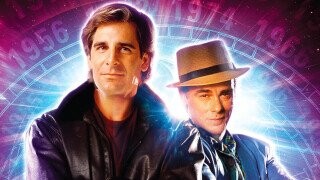‘Quantum Leap’s Crappy Finale Has A Touching Backstory

Because fresh story ideas can sometimes be even harder to crack than body-swapping time travel technology, this week we’re getting a new version of Quantum Leap, the beloved late ‘80s/early ‘90s sci-fi series about a scientist who’s propelled by a mysterious cosmic force to right wrongs throughout history, such as … helping a pint-sized Donald Trump build his real estate empire? What the hell?
The new show seems to be following that same story, the only major difference being that the protagonist’s holographic sidekick is now a love interest from the future, not a cigar-chomping horndog who seemingly buys all of his clothes from Dan Flashes.
2022’s Quantum Leap isn’t a straight-up remake, it’s essentially a sequel, taking place within the world of the first show. While the star of the original, Scott Bakula, has claimed that he is in no way involved in the project, many fans saw the revival as an opportunity to “fix” the finale, which, as we’ve mentioned before, is one of the most depressing endings to a TV show ever.
The last episode of Quantum Leap finds Dr. Sam Beckett leaping into a mysterious, otherworldly small town bar, where his mirror image is now his own. Also, the bartender may or may not be God.
While this episode wasn’t intended to be the series finale, the show was canceled – so someone just slapped a title card at the end of the episode stating that “Dr. Sam Becket never returned home.” Yup, they doomed the show’s hero and sloppily misspelled his name in literally the final few seconds, kind of like if Gilligan’s Island ended with a few lines about how everyone got eaten by sharks in the end.
But as notoriously disappointing as the ending might have been, most of the episode was still pretty good – and has a genuinely touching story behind it. According to Quantum Leap’s creator Donald P. Bellisario, the bar seen in the finale was a recreation of his father’s real-life bar from the 1950s, complete with “every detail” that he could remember or “find in photographs.”
He even used the same taps that were from his dad’s joint and admitted that he came up with the story not only as an homage to his dad but just because he wanted to “sit there and be back there” – ultimately realizing that it was “the people” which made it special, not the structure itself. Basically, it was a heartwarming version of a Nathan Fielder stunt.
You (yes, you) should follow JM on Twitter!
Thumbnail: NBC